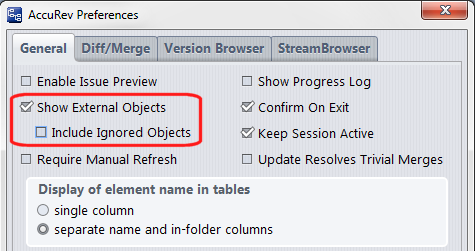Controlling the Display
Controlling the Display of Element Names
Typically, the elements displayed in the Details pane are located in a number of different folders, throughout the workspace. A user preference controls how to display the locations of the elements:
- Display the complete depot-relative pathname of the object as a single string (Element column).
-
Display the object's simple name (Name column) separately from the pathname to its parent directory (In Folder column).

In Tools > Preferences, use the Display of element name in tables preference to make this choice. It affects all instances of the File Browser, along with other tools that display element pathnames.
Tip: You can add and remove columns in the Details pane as you would with any other table in AccuRev. See Working with Tables for more information.
Controlling the Display of External Objects
Note: This topic applies to a File Browser displaying the contents of a workspace — not a dynamic stream or snapshot.
By default, the Details pane of the File Browser shows both elements and external objects. The Show External Objects preference provides an all-or-none control over the display of external objects — even those external objects you might have instructed AccuRev to ignore when they match a user-specified ignore pattern.

If you also want AccuRev to display ignored external objects, select the Include Ignored Objects preference, too.
See AccuRev Preferences (Tools > Preferences Command) to learn more about setting preferences in AccuRev.
Saving Layout and Other Usage Preferences
As described previously, you can customize the File Browser to suit your needs — you can choose which columns you want to display, and in which order; you can change the relative widths of the Explorer and Details panes; and you can choose to hide the Diff pane in the modes that support it, for example. The Save Layout button (![]() ) lets you save these and other changes you make to default File Browser layout settings as a personal preference. Once saved, AccuRev uses your customized layout settings the next time open a new File Browser.
) lets you save these and other changes you make to default File Browser layout settings as a personal preference. Once saved, AccuRev uses your customized layout settings the next time open a new File Browser.
For example, you might decide that the Last Modified column is useful in the Outgoing Changes mode, that the default height for the Diff pane is too tall, and that you are generally interested in seeing only those files with a (modified) status. Once you set up Outgoing Changes mode to your liking, clicking the Save Layout button saves these settings — as well as any changes made in other File Browser modes — and makes Outgoing Changes the new default mode the next time the File Browser is opened.
What Settings are Saved?
The Save Layout button saves these settings:
- Mode — The mode you are in when you click Save Layout becomes the default mode the next time you open the File Browser. Within the Explorer mode, AccuRev also saves the setting for the Include/Exclude View as a preference.
- Columns — AccuRev lets you save changes to Details pane columns, column width, order, and sort order.
- Diff pane — The Diff pane is displayed by default, but you can change this setting and save it using the Save Layout button.
- Status filters — AccuRev remembers status filter settings for modes that support them.
- Splitters — AccuRev lets you save any changes you make to the relative layout of the Explorer, Details, and Diff panes.
- Timestamp Optimization option — Whether or not AccuRev uses cached server information to identify modified files in the workspace. See The Explorer and Details Panes in Explorer Mode for more information. (This setting is not available in Incoming Changes mode.)
- Include Deep Overlaps option — Whether or not AccuRev searches for overlap files beyond time-basis streams to identify elements with a so-called "deep" (overlap) status. See Types of Conflicts Displayed in Conflicts Mode in Conflicts Mode for more information. (This setting is applicable to Conflicts mode only.)
Note that AccuRev saves layout settings for the workspace File Browser and stream File Browser separately.
How to Save Layout Settings
To save layout settings:
- Open the File Browser for the workspace or stream whose default layout settings you want to change.
- Make the changes that you want in each mode — add and remove columns, changes their order and width, and so on.
-
Are you in the mode that you want AccuRev to use as the default mode the next time you open the File Browser?
- If yes, click the Save Layout button. If no, change to the desired default mode and click the Save Layout button
- AccuRev uses these settings the next time you open the File Browser of the type whose settings you just modified.












